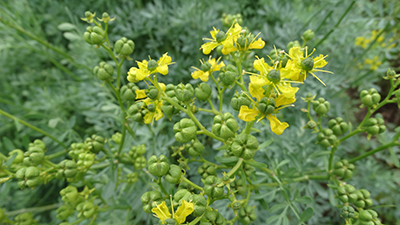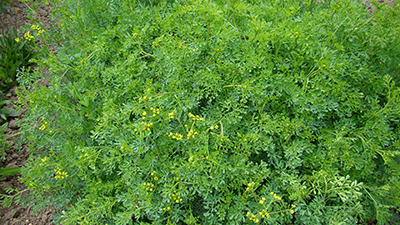Ruta graveolens L. (Rutaceae)



| ENG | Common rue |
| SK | Ruta voňavá |
| CZ | Routa vonná |
| PL | Ruta zwyczajna |
| HU |
Using
Since ancient times, rue has been used for treatment of eye problems, rheumatism, dermatitis, pain and many inflammatory diseases. The essential oil is spasmolytic, anti-inflammatory, antihistaminic, and is a vermifuge. Rue can also be applied in poultices for rheumatic pain, dislocations, tendon strains, varicose veins and skin conditions such as psoriasis and eczema. It has bitter eupeptic properties, so it is prescribed for stomach and intestinal disorders. It was not recommended for use by pregnant women because it may provoke hyperemia in the uterus and cause abortion.
| I. | II. | III. | IV. | V. | VI. | VII. | VIII. | IX. | X. | XI. | XII. | |||||||||||||
| Sowing | ||||||||||||||||||||||||
| Harvest (herb) | ||||||||||||||||||||||||
Botanical description and occurrence:
Rue is a herbaceous perennial, native to the Mediterranean Basin but it has been introduced worldwide due to its cultural and medicinal value. Rue is a small, evergreen sub-shrub or semi woody perennial, up to 1 m tall and almost as wide. Leaves are dissected pinnately into oblong segments, fleshy and usually covered with a powdery bloom. Flowers are small, arranged in paniculate clusters. Fruits are dry, hard rounded, 4 or 5 lobed at the top, grayish-brown and rough.
Why to have the plant in your garden:
Rue is a plant for brave gardeners. It can be a beautiful part of garden arrangement but do not provide aromatic impression because of strong, heavy and unpleasant smell. It should not be touch in sunlight, because of the risk of skin photosensitivity, caused by furanocoumarins. The essential oil is a central nervous system depressant, and at high doses - a narcotic poison.
Text:
Dr. Agnieszka Sekara, University of Agriculture in Krakow, Poland
Photo:
Dr. Agnieszka Sekara, University of Agriculture in Krakow, Poland

